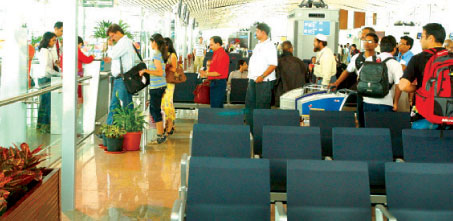A joint venture company promoted by GMR Infrastructure Ltd – GMR-HIAL – aspired to develop a world class international airport spread close to (25km) Hyderabad city.
New Hyderabad International Airport opened on 23 March, following a seamless terminal transfer from Begumpet, which is no longer open to civil operations, to Shamshabad, the airport’s new location.
India’s world class airport
“From concept to commissioning in less than eight years, with an investment outlay of $550 million (€352 million) in an Indian environment, working with multiple stakeholders and not a single flight cancellation on opening, Hyderabad International Airport is a commendable achievement for any Indian corporate house and should make every Indian proud,” said Kiran Kumar Grandhi, chairman and managing director at GMR Hyderabad International Airport.
23 airlines currently operate from the airport, connecting to 35 destinations.
The airport has a current floor space of 105,300sqm, which will be developed in phases based on the air traffic trigger principle, with initial passenger handling capacity of 12 million passengers (under Phase IA) and cargo capacity over 100,000 tonnes per annum. Phase 2 will commence when triggered by traffic volume, with plans to increase passenger capacity to 20 million. The airport will reach its full maturity in the Final Phase, with an additional floor area of 430,000sqm, bringing the total floor area to 900,000sqm with the capacity for 40 million passengers. Further acquisition of land to the north and south will allow the expansion of a third and fourth runway system, when required.
The airport boasts India’s longest runway at 4,260m – making it A380 compatible – with 10 runway entry and exit points, including four rapid exit taxiways, plus India’s longest taxiway measuring 4,260m which can be used as an emergency runway for take off. The terminal building is equipped with modern technology, including 130 CUTE (Common Use Terminal Equipment) check-in counters and 16 CUSS kiosks.
The project also includes provisions for a Low Cost Terminal (LCT), a Wi-Fi enabled terminal building and specially designed PRM (Passengers with Reduced Mobility) facilities. Additional developments include the ATC tower, technical buildings, cargo (100,000 tonnes capacity), CFR Station (Crash, Fire and Rescue Station) and utilities, and a 308-room business hotel and parking for 3,700 cars in front of the terminal.

Capacity is currently 12 million passengers and when Phase 2 commences – triggered by traffic volume – capacity will be increased to 20 million, potentially reaching 40 million passengers in the final phase and bringing the total floor area to 900,000sqm.
India’s A380 capabilities
As the only A380 capable airport in India, Hyderabad is in a premium position. As the civil aviation sector undergoes dramatic changes, underlined with mounting pressure to cater for all parties needs at economic fares, while reducing overhead costs, Grandhi believes that the A380 is vital for driving India’s air transport growth.
“The airports in India, like Hyderabad, will integrate into the network on a global scale with other large international airports like Dubai and Changi. An A380 compatible airport facility at Hyderabad or Delhi will help airlines offer passengers a better service as well as help accelerate the Indian civil aviation sector integration into the global airport network faster and more efficiently,” said Grandhi.
Grandhi accredits the accelerated GDP growth, Hyderabad’s leadership position in the IT and ITES (Information Technology Enables Services) industry, low-cost carriers and the emergence of a strong middle class, as factors that will shape phenomenal growth.
“I believe that airports are going to shape the economy of the country or region in the 21st Century and India is no exception. Indian aviation is heading towards an aggressive growth in the medium term and sustainable growth in the long run,” said Grandhi.







